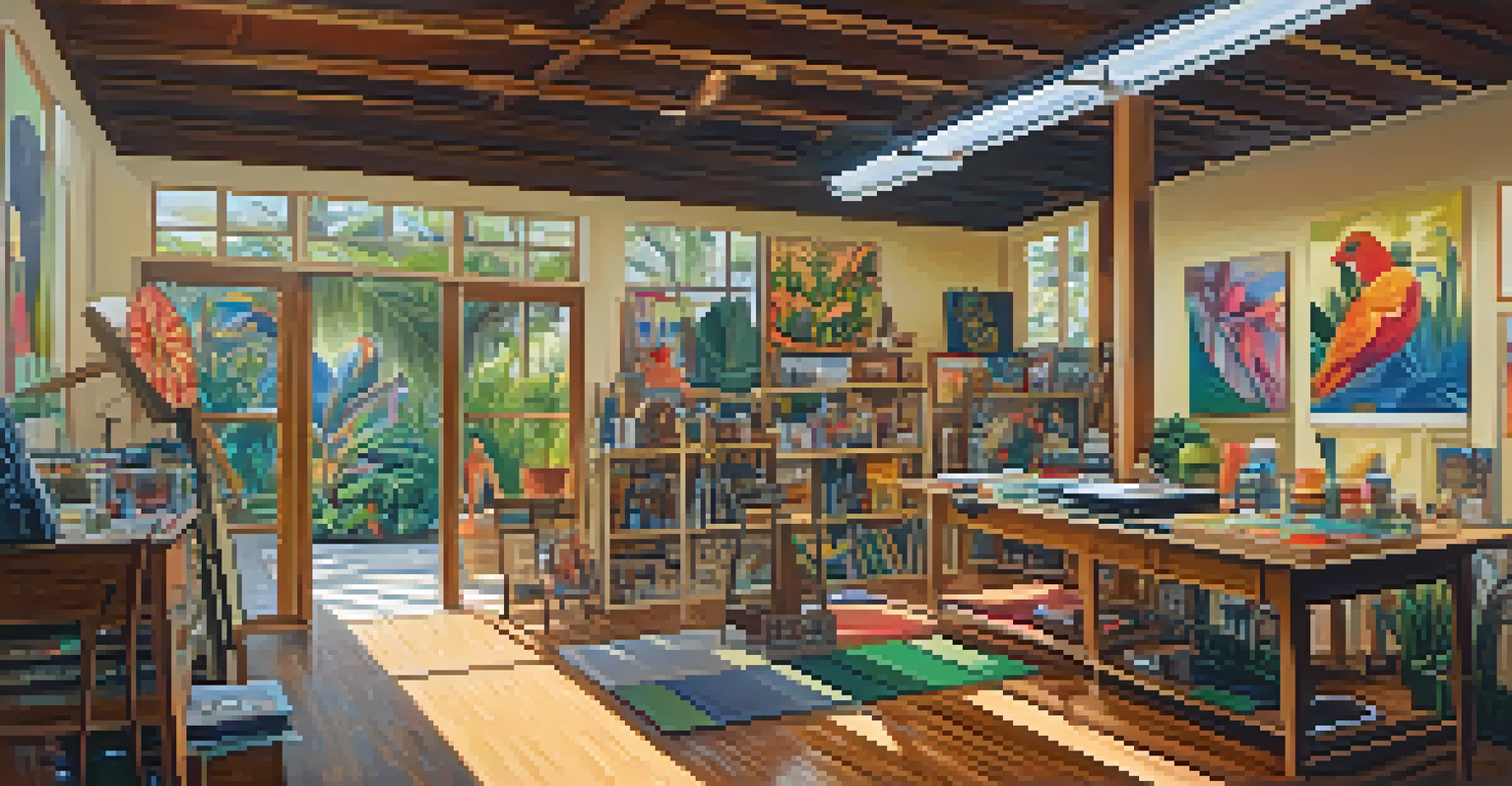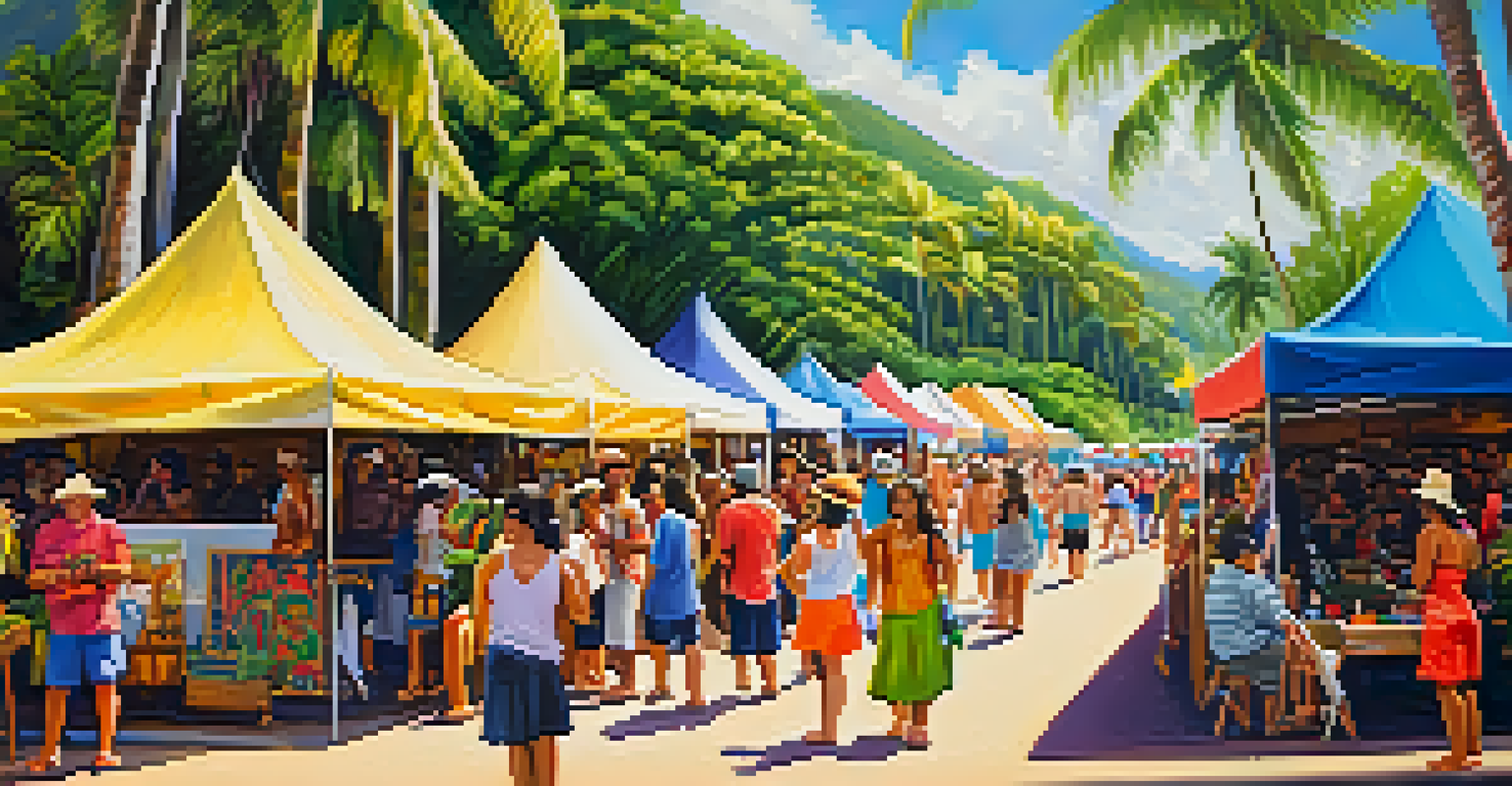The Evolution of Visual Arts in Hawaii: A Historical Overview

Ancient Hawaiian Art: Spiritual and Cultural Foundations
The roots of visual arts in Hawaii can be traced back to ancient times, where art played a significant role in spiritual and cultural practices. The early Hawaiians created intricate petroglyphs, or rock carvings, that depicted gods, myths, and everyday life, serving both artistic and religious purposes.
Art is the most beautiful of all lies; it is a great illusion to which we aspire.
These ancient artworks were not merely decorative; they were vital in passing down traditions and stories from one generation to the next. The use of natural materials, such as wood, stone, and feathers, showcased the deep connection between the Hawaiians and their environment.
As these art forms evolved, they laid the groundwork for a unique Hawaiian aesthetic, blending functionality with profound cultural significance. This period set the stage for the artistic transformations that would follow with the arrival of Western influences.
Colonial Influence: The Shift in Artistic Expression
With the arrival of European explorers and missionaries in the 18th century, Hawaiian art began to undergo significant changes. New materials and techniques were introduced, altering traditional practices and paving the way for a fusion of styles.

Artists started to incorporate Western themes and subjects into their work, leading to the creation of portraits and landscape paintings that reflected the changing society. This blending of artistic ideas marked a pivotal shift, as local artists began to explore their identity through a new lens.
Ancient Roots of Hawaiian Art
Hawaiian visual arts originated in ancient times, serving spiritual and cultural purposes through intricate petroglyphs and natural materials.
While some traditional practices waned, this period also sparked a renaissance of sorts, as artists sought to reinterpret their heritage amidst foreign influences. The colonial era ultimately enriched the Hawaiian visual arts scene, creating a vibrant tapestry of cultural expression.
The 20th Century: Modernism and Cultural Reclamation
The 20th century marked a significant turning point for Hawaiian visual arts, as artists began to embrace modernism while also reclaiming their cultural heritage. This era saw the emergence of artists who celebrated their Hawaiian identity through various mediums, including painting, sculpture, and photography.
The essence of art is to be a part of the world, to create a new path in the wilderness of tradition.
Notably, artists like Jean Charlot and Isami Doi played crucial roles in redefining Hawaiian art by incorporating traditional themes into contemporary formats. Their work resonated with both locals and tourists, fostering a deeper appreciation for authentic Hawaiian artistry.
This desire to connect with their roots led to a resurgence of traditional practices, as more artists sought to honor their ancestors through their creations. The blending of modern techniques with cultural motifs became a hallmark of this innovative period in Hawaiian visual arts.
Contemporary Art: A Diverse and Dynamic Scene
Today, the visual arts in Hawaii are incredibly diverse, reflecting a melting pot of cultures and influences. Contemporary artists continue to push boundaries, exploring themes of identity, environment, and social justice through their work.
Art galleries and exhibitions showcasing local talent have flourished, providing platforms for emerging artists to share their unique perspectives. Events like the Honolulu Biennial highlight the vibrant arts community and its connections to global conversations.
Colonial Impact on Artistic Styles
The arrival of European explorers in the 18th century led to a fusion of traditional Hawaiian art with Western themes, redefining local artistic expression.
Incorporating traditional techniques with modern concepts, contemporary Hawaiian artists are redefining what it means to be an artist in Hawaii. This dynamic scene not only enriches the local culture but also attracts art enthusiasts from around the world.
The Role of Education in Art Evolution
Education has played a pivotal role in the evolution of visual arts in Hawaii. Institutions like the University of Hawaii have been instrumental in nurturing local talent and fostering a deeper understanding of both traditional and contemporary practices.
Art programs encourage students to explore their cultural heritage while also engaging with modern artistic techniques. This blend of education is essential in ensuring that future generations carry forward the rich traditions of Hawaiian art.
Workshops, community programs, and collaborations with established artists create opportunities for hands-on learning and cultural exchange. As a result, the next wave of artists is equipped to contribute to the vibrant tapestry of Hawaii's visual arts scene.
Community Engagement: Art as a Connector
In Hawaii, art serves as a vital connector within the community, fostering relationships and building bridges across diverse cultures. Local festivals and events often feature visual arts prominently, allowing artists to interact with the public and share their stories.
Initiatives like mural projects and public art installations not only beautify neighborhoods but also engage residents in the creative process. These collaborative efforts celebrate the uniqueness of Hawaiian identity while promoting a sense of belonging.
Contemporary Art's Cultural Fusion
Today, contemporary Hawaiian artists blend traditional techniques with modern themes, creating a dynamic arts scene that resonates globally.
Through art, communities are able to express their shared history, challenges, and aspirations. This collective engagement not only enriches the local culture but also strengthens the bonds among residents, highlighting the power of visual arts as a unifying force.
The Future of Visual Arts in Hawaii: Trends and Innovations
Looking ahead, the future of visual arts in Hawaii appears promising, with new trends and innovations shaping the landscape. Artists are increasingly exploring digital mediums, using technology to create immersive experiences that resonate with younger audiences.
Sustainable practices are gaining traction, as artists seek to minimize their environmental impact while celebrating the natural beauty of the islands. This commitment to sustainability resonates deeply with the values of the community and reflects a growing awareness of global issues.

As the art scene continues to evolve, collaboration across disciplines and cultures will remain crucial. Embracing change while honoring tradition ensures that Hawaiian visual arts will thrive, captivating hearts and minds for generations to come.